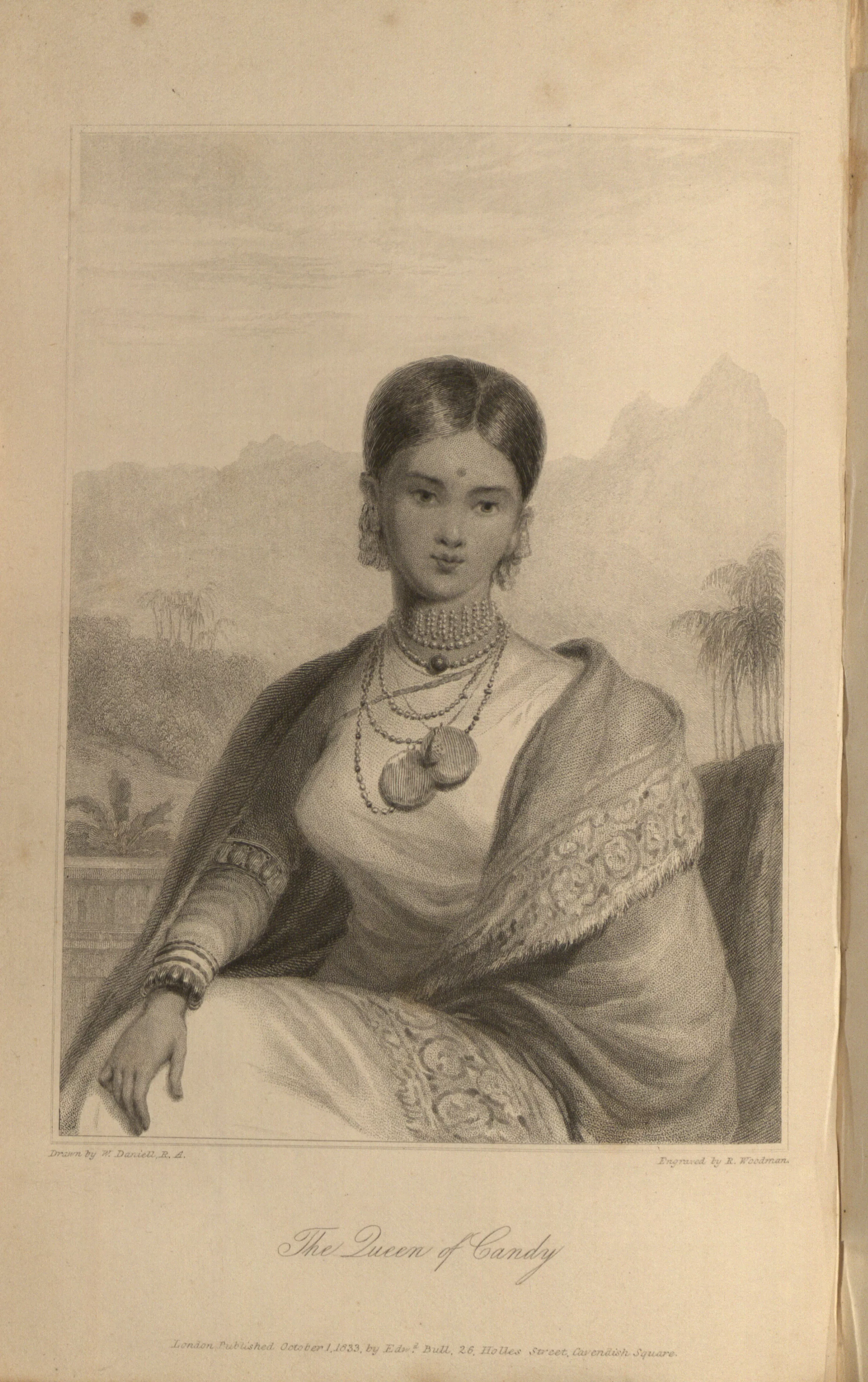Exhibit
Creation Date
10 January 1833
Medium
Genre
Description
The Queen of Candy, the Candian king’s daughter, poses in a chair, legs crossed, against a mountainous landscape. Her elongated neck is covered with exotic, shell-like jewelry. Her hair is bound tightly back and garnished with a loop of flowers. She averts her gaze from the viewer and modestly covers her shoulders, exposing only one, small hand. Unlike most depictions of native Indian subjects, her demure features are set in a round, child-like face.
By representing the Queen of Candy as an individual rather than a type, this image attests to the mutuality and tolerance definitive of many Indian-British relationships prior to the India Act of 1784.
Falling under the genre of "travel books," The Oriental Annual, or Scenes in India constituted a combination of fictional travel accounts and instruction manuals. They were widely distributed and read; many book reviews regarding The Oriental Annual are found in periodicals of the time.
At the age of fourteen, William Daniell accompanied his uncle Thomas Daniell, a landscape painter trained at the Royal Academy, on a journey to India from 1786 to 1794. The first two years were spent in Calcutta preparing Views of Calcutta. After the first two years they traveled to the Punjab Hills and then back to Calcutta in 1971. They began a second tour in 1792, working their way through Mysore and Madras. After staying in Madras from 1793 to 1794 they finally returned to England. Drawings made during these trips were engraved in books and prints (some of which were exhibited at the Royal Academy).
The Daniells arrived in India during a period of political transition, just after the departure of Warren Hastings and prior to the instatement of Charles Cornwallis (1738-1805), the new Governor-General of India. Cornwallis was the first Governor-General appointed under the new India Act of 1784 (passed during William Pitt's term as British prime minister). The act was passed in part as a means of reigning in the Hastings style of government, which was seen as “too indigenous, free-wheeling and popular, too benevolent and multi-national and not British enough” (De Almeida 168). Hastings became known for incorporating native Indians as administrators, financers, and civil servants. The India Act proceeded to centralize Company administration: a six-member Board of Control was created which controlled the Company’s possessions abroad, and the Governor-Generalship was made a Crown appointment with full control over other governors and presidencies in India. Additionally, the act created a centralized British military in India.
Charles Cornwallis (1738-1805) gained experience in the military while serving in America, and was employed to carry out England’s imperialist vision in India. His strategic military victories on land (for example, in Mysore with Tipu Sultan) not only extended England's rule, but also provided sepoys that could be recruited and kept on reserve for the Napoleonic Wars. Additionally, Cornwallis’ belief that “every native of Hindoostan is corrupt” gave way to a purging of Indian natives from administrative positions and forbid mixing or socializing between races. A purification and segregation process, in which hybridity was especially scorned, took place under Cornwallis’s rule (De Almeida 168). Dalrymple claims that “these new racial attitudes affected all aspects of relations between the British and Indians” (Dalrymple 41). Prior to Cornwallis’s strict racial segregation, many British officials were integrated into Indian society by learning the language, adopting Indian dress and mannerisms, and marrying Indian women (bibis). The decline of this integration became apparent with the declining rates of bibis on wills; by the mid-nineteenth century no records of bibis on wills exist (Dalrymple 1). Even though these changes brought about tension between the British and Indians, many British officials continued to be patrons of Indian art (Archer 1-15).
In contrast to either The Fruit Seller or The Hindoo Female, the subject of The Queen of Candy has an official name and title. She is represented as an individual rather than as a generic type. Daniell’s slippage between types and individuals reflects the less-prescribed nature of the relationships between the British and the Indians prior to the early-nineteenth century, when an intolerance for hybridity became the norm. Additionally, the encounter between the Candian King and the Daniells reflects a different power dynamic than that occuring between a colonizer and colonized subject. Many British artists in the mid- to late-eighteenth century were traveling to India in order to make their fortunes as artists, and consequently worked for wealthy Indian nawabs (Sutton).
Locations Description
The East India Company was formed to trade with East and Southeast Asia and India and was instituted by royal charter on Dec. 31, 1600. Although it started as a monopolistic trading company, it soon became involved in politics and acted as an instrument of British imperialism in India from the early eighteenth century to the mid-nineteenth century. The company was founded with the hope of dominating the East Indian spice trade. This trade had been a monopoly of Spain and Portugal until the defeat of the Spanish Armada in 1588 gave England the opportunity to appropriate the lucrative market.
Publisher
Bull and Churton (or Bull and Co)
Accession Number
AY 13 O7 1834
Additional Information
Bibliography
Archer, Mildred. Early Views of India: The Picturesque Journeys of Thomas and William Daniell, 1786-1794: The Complete Aquatints. New York: Thames and Hudson, 1980. Print.

